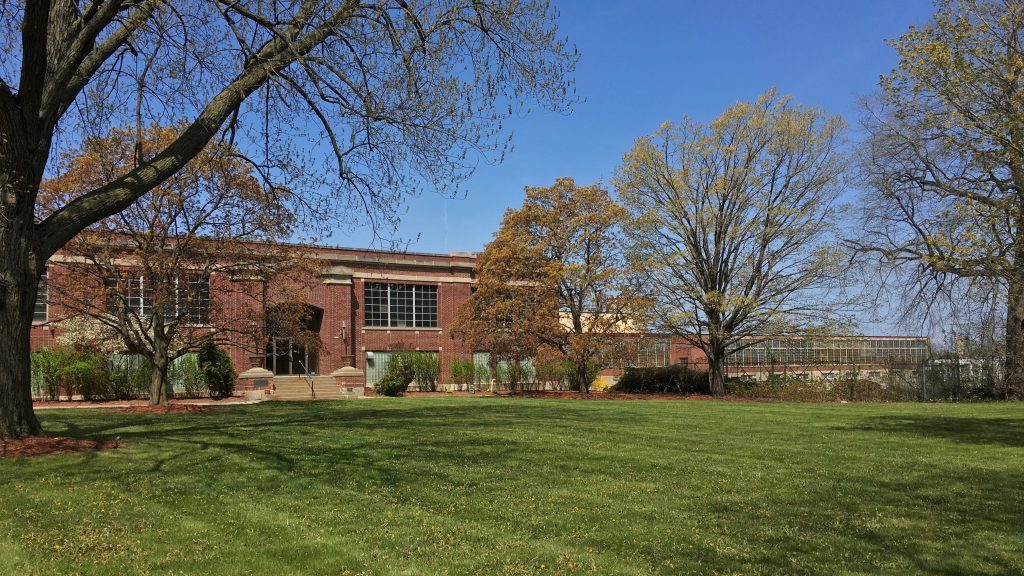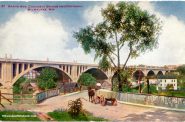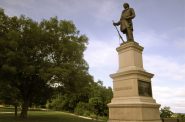Riverwest Had World’s Largest Color Printing Press
In 1922, genius innovator Leslie Claybourn built a unique factory on Humboldt and Keefe.

The former Cottrell & Sons, Claybourn Division printing press manufacturing plant at 3701 North Humboldt Boulevard is vacant today but it has a proud heritage. Carl Swanson photo.
A color printing press is a miraculous machine. As big as a house (and the newest ones are much bigger than that), packed with rollers and gears turning at blinding speed, producing tens of thousands of printed sheets per hour, they are so precisely made that a single part misaligned by a few thousandths of an inch would ruin the output.
One of the early pioneers in color printing, Leslie Claybourn, built a factory in Riverwest in 1922 and his workers were soon turning out printing presses that were more innovative, more massive, and more precise than any before. His company attracted visitors from around the globe and even held the record for a time for the world’s largest color press.
Then, in 1957, it all came to an end. Other companies would occupy the 172,344-square-foot factory at 3701 North Humbolt Boulevard over the subsequent years but it stands empty today.
Leslie Claybourn was born in Albert Lea, Minnesota, in 1884. He started an electroplating company and then a machine shop. Business being slow at times, he augmented his income by moonlighting as a professional wrestler. Known as Lex “The Terrible Swede” Claybourn, he was good enough to hold the lightweight championship at one point.
His patented techniques, involving both improved machinery and new ways of producing printing plates, attracted a great deal of industry attention. In 1921 he was able to organize the Claybourn Process Corporation and built a large factory on Humboldt near Keefe Avenue.
One of the company’s first customers was the Milwaukee Journal. Other newspapers followed, including The New York Times. The Philadelphia Inquirer, Cleveland Plain Dealer, and many more. By 1929, Conde Nast was printing Vogue on a Claybourn five-color press.
In a 1929 article, a national trade publication, The Pressmen’s Journal, wrote, “Mr. L.W. Claybourn is one of the outstanding geniuses of the printing industry of the world, and it has been said by many authorities in the printing and printing machinery fields that Mr. Claybourn is actually 25 years ahead of the industry.”
On the last day of 1930, Claybourn’s car was involved in a collision at the interaction of North Prospect and East Newton avenues. So violent was the impact that Claybourn’s car was thrown sideways into a unity pole, snapping it off at its base. He spent all of 1931 in a cast and never fully recovered from his injuries.
It would take more than that to sideline “The Terrible Swede.” In 1934, the Claybourn company made headlines when it unveiled a 72-ton five-color press able to print 4,000 sheets per hour while cutting set-up time in half. The gain in efficiency was startling. This high-speed full-color press could be up and running as quickly as a relatively simple two-color press.
But in those dark years of the Great Depression excellence in design and manufacture might not be enough to save a company. In 1937, with the Milwaukee plant struggling to stay afloat, Connecticut-based C.B. Cottrell & Sons Company acquired the firm.
Claybourn stayed briefly to help with the transition, then moved on to work with many other printing firms. At the time of his death in 1956, he held more than 200 patents for printing innovations.
The Riverwest plant’s new owner, Cottrell & Sons, traced its roots as a machine builder all the way back to 1855. By the time of the Civil War, the firm was specializing in printing presses. The firm sent Donald Cottrell, grandson of the founder, to manage its newly acquired Milwaukee operation. A graduate of Harvard, he had served as captain of an infantry company in World War I. He also had a local connection—Charles Ilsley, chairman of the board of Marshall & Ilsley Bank, was a classmate of his at Harvard.
Cottrell would lead the company out of the Depression and through years of wartime production in World War II.
In 1953, Cottrell & Sons was itself taken over by the Harris-Seybold Co. and the Milwaukee plant had another owner. By 1955, the factory had 165 employees and was building rotary color presses that weighed 40 tons and measured 42 feet long.
Two years later, Harris-Seybold closed the Humboldt factory and a piece of Milwaukee’s industrial heritage died.
In 2015, the Wisconsin Historical Society sponsored a survey to find industrial properties that might be eligible for inclusion in the National Register of Historic Places. The report concluded the C.B. Cottrell & Sons, Claybourn Division factory is “significant as an example of an early-twentieth-century industrial complex with a consolidated plan. The first factory and warehouse were constructed in 1922, and the Classical Revival main office was constructed in 1927. In the 1950s and 1960s, the plant expanded at the rear; however, the complex retains the character-defining features of the form including the large expanses of original window sash, roof lighting, and a consolidated plan. The C.B. Cottrell & Sons buildings retain a high degree of integrity and are therefore potentially eligible.”
If a historical marker is erected, which seems unlikely, it might quote the founder, Leslie Claybourn, who told The Pressmen’s Journal in a 1929 interview, “Printing is a mechanical problem. Establish accuracy and precision into the locked-up form to be printed or moulded from, which is the very foundation of the printed job, and you will print that form correctly in spite of yourself.”
Maybe it could also mention the tomatoes.
Carl Swanson is the author of the book Lost Milwaukee from The History Press, available from book stores or online.
Lost Milwaukee
-
When Police Handed Out Courtesy Cards
 Jul 14th, 2020 by Carl Swanson
Jul 14th, 2020 by Carl Swanson
-
The Mighty Grand Avenue Viaduct
 Apr 29th, 2020 by Carl Swanson
Apr 29th, 2020 by Carl Swanson
-
The Man Who Made Milwaukee
 Mar 9th, 2020 by Carl Swanson
Mar 9th, 2020 by Carl Swanson






















Very nice article, Carl!